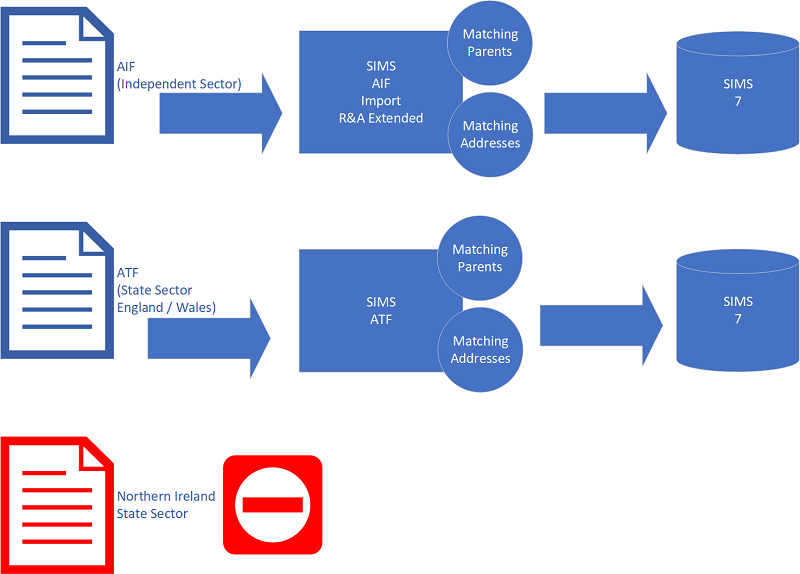SIMS 7 - Applicant Import
Getting applicants from admission systems into SIMS
Technical Integrators have expressed interest in the creation and maintenance of applications within SIMS and this page sets out to explain the journey required.
Whilst adding an applicant may seem simple in principle, it brings in a set of challenges:
- How do we know if the applicant exists already?
- Do they have a sibling at the school?
- How do we locate the sibling?
- Do their parents exist in SIMS?
- How do we locate existing parents?
- How do we ensure that we
- Don't create duplicates
- Don't match to the wrong parent
The challenge is caused because applicants may not have a UPN (Unique pupil number) and parents certainly don't have an available unique identifier and historically have been inconsistently recorded, for example:
- Mr A McGowan
- Mr Andy McGowan
- Fg Off A McGowan
- Fg Off Andrew McGowan
- Mr andy mc gowan
- ...
Thus it is almost certain that some form of user intervention is needed to confirm or rebut that the exiting record for:
- A Mcgowan - Mother - 1 Arcadia Avenue
Is or is not the Fg Off Andrew McGowan within the admissions system.
Our recommendation for TI's is to use the tools which are quite complex and exist in SIMS already for importing admissions files. This then takes care of the edge cases and matching headache above. All that the TI needs to do is to generate the correct file for the sector, see below and let SIMS do the donkey work.
We offer different import formats for different market sectors, ATF (DfE Standard) and AIF.
NB: ATF/AIF are intended as a once only import, unlike CTF (Common transfer file) which is intended to support update. CTF however is intended to support import and update but keyed on UPN which may or may not be available within the admissions process.
The ideal cut off point between the admissions system and SIMS is the point at which the application is 'Accepted'. Accepted pre-admissions in SIMS can be:
- Timetabled
- Added to classes
- Registered
- ...
Hence ideally the ATF/AIF is created at that point and pushed to SIMS with SIMS then having the data primacy. Typically schools admit accepted applicants early in the term in which they are due to arrive, usually waiting for pupil to arrive in the class before pushing the 'Admit' button in SIMS. Admitting a new intake is a straight forward process in SIMS for the user (but complex under the hood) and we would not recommend duplicating the process within TI applications because of the complexity vs the number of times that it is used per year within the school (2 or 3 perhaps).
It is also possible to use standard coding techniques to update applicants once imported. [This will be the topic for another page to follow].
Warning: When an applicant is admitted, they become a 'student'. Students are stored separately in SIMS although they share a 'person' object. As such once the application has a status of admitted then it would be usual to update the 'Student' and not the 'applicant'. Some updates such as Forename would be seen in both, others such as updates to parental responsibility may not!
It is common for end customer to want this process to be fully automated and this is possible but is an interesting GDPR challenge and will usually involve the TI replicating all of the code in the SIMS import routines at a significant time cost to the TI.
Post Script
Since the initial publication of this article there have been examples of technical integrators implementing the creation of applicants and management thereof bypassing ATF/AIF and so it is clearly possible to do. Thought must be given to how the imports will manage de-duplication and ensure that any links made to existing people in SIMS will be correct. Consider the edge case below:
Applicants:
- John Smith - Mum Jane and dad John
- John (Johny) Smtih - Mum Jan and dad John
SIMS has
- Jane Smith - Pupil with mum J and dad J
- Lisa Jane Smith - Pupil with mum Jane and dad J
If the process created within the TI application allows the school to correctly mix and match so that all 4 of the above have the same father, but different mums with similar names then it may be GDPR secure. In addition, care needs to be taken with addresses to avoid them all living together or living at duplicated addresses for the same residence. We would certainly recommend that any Ti implementing admissions import from scratch consider consultancy and would almost certainly need developer support in their package.



